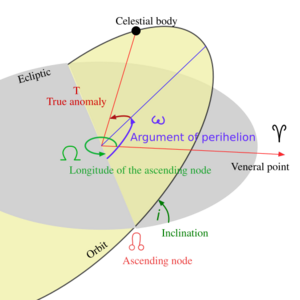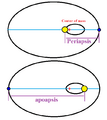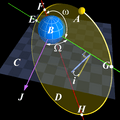Apsis facts for kids
An apsis (pronounced AP-sis) is a special point in the journey of an object orbiting another. Imagine a planet like Earth going around the Sun. Its path isn't a perfect circle; it's an oval shape called an ellipse. An apsis is either the point where the planet is closest to the Sun or the point where it is farthest away. This idea applies to anything orbiting something else, whether it's a satellite around Earth or a star orbiting a black hole.
Contents
Understanding Apsides
In astronomy, an apsis (plural: apsides) describes the two extreme points in an object's orbit. These points are where the orbiting object is either at its closest or farthest distance from the main object it's circling. This main object is usually the center of mass of the whole system. Think of it as the balancing point if you were to weigh both objects together.
Periapsis and Apoapsis
There are two main types of apsides:
- The point where the orbiting object is closest to the main object is called the periapsis or pericentre. The word "peri-" comes from Greek and means "near."
- The point where the orbiting object is farthest from the main object is called the apoapsis, apocentre, or sometimes apapsis. The word "apo-" comes from Greek and means "away from."
Imagine drawing a straight line through both the periapsis and the apoapsis. This line is called the line of apsides. It's the longest part of the elliptical orbit, also known as the major axis of the ellipse.
Special Names for Apsides
Scientists use specific names for apsides depending on what the object is orbiting:
- Perigee and Apogee: When an object, like the Moon or a satellite, orbits Earth, the closest point is the perigee, and the farthest point is the apogee.
- Perihelion and Aphelion: When a planet or comet orbits the Sun, the closest point is the perihelion, and the farthest point is the aphelion.
Images for kids
-
The two-body system of interacting elliptic orbits: The smaller, satellite body (blue) orbits the primary body (yellow); both are in elliptic orbits around their common center of mass (or barycenter), (red +). ∗Periapsis and apoapsis as distances: The smallest and largest distances between the orbiter and its host body.
See also
 In Spanish: Ápside para niños
In Spanish: Ápside para niños




